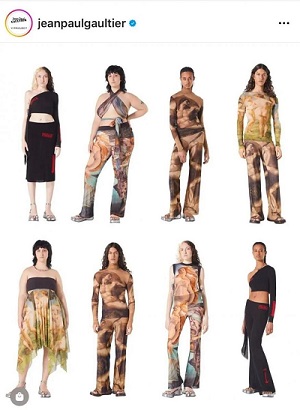"Unauthorized use of Botticelli's Birth of Venus": that's the motivation of the lawsuit started by the Uffizi Museum in Florence, one of the best know museums in the world, against the famous fashion stylist Jean Paul Gaultier.
The fashion house unveiled its new ready-to-wear collection, called Les Musée, in April this year, showing some pieces (scarfs, trousers, shirts, tops) reproducing The birth of Venus, famous work by Botticelli painted around 1485.

Photo source: JP Gaultier Instagram official account
In this capsule collection, Jean Paul Gaultier used not only Botticelli's work, but also other images of well-known art: The creation of Adam, a fresco by Michelangelo painted in the Sistine Chapel in Rome between 1508 and 1512, and the Three Graces by Rubens, kept in the Museo Nacional del Prado in Madrid.
The Uffizi Museum claims that Gaultier did not approach them to ask permission for the use of the masterpiece, nor to pay the fee due for it: in April, as soon as the museum discovered the illicit, it sent out a cease-and-desist letter, asking Gaultier to stop selling products reproducing the Botticelli masterpiece or at least to get in contact with the museum to set an agreement for the payment of the fee.

Photo source: JP Gaultier Instagram official account
Gaultier did not answer to the Uffizi, so now the museum is suing the fashion house, asking not only to recall all the products already sold, but also for a compensation.
But why does Gaultier have to pay for the use of such piece of art? Isn't the copyright expired?
What the Uffizi refer to is a norm which basically is a right of reproduction and behaves like a copyright even if formally it is not a copyright (it looks more like a related right). In fact, it is found in the Code of Cultural Heritage (Legislative Decree 42/2004, a text that can be placed in the context of administrative law) and not in the Copyright Law (Law 633/1941).
In spite of the insertion of a paragraph 3-bis which establishes a series of exceptions to free use (private use, study or non-profit activity), this principle acts as a copyright de facto and limits the reproduction of works that have been the cultural heritage for centuries, as they have become in the public domain; works that therefore belong to everyone, and at the same time to nobody.
Therefore, despite not being under the protection of copyright law (the author is dead since more than 70 years), according to the Italian Law everyone who wants to use the image of a piece of art housed in an Italian museum must ask permission to that museum, agree on how to use it and pay the fee.
"Jean-Paul Gaultier has boutiques in Italy and sells his products through Italian web channels too. Therefore, like everyone, he is required to respect our laws on image rights", explains the director of the Uffizi, Eike Schmidt, who in the past has already taken action to defend the interests of the museum against the improper use of his masterpieces.
This is the Italian law.
But.
In 2019 the European legislator issued a directive (790/2019 on copyright and related rights in the digital market). Among the various innovative principles introduced, the Article 14 deals precisely with reproduction rights on "works of visual art" that have already fallen into the public domain: in other words, paintings, frescoes, sculptures, lithographs, photographs by authors who have died for more than seventy years and therefore with an "expired" copyright.
The meaning of this art. 14 is clear: once the works have fallen into the public domain, it is no longer possible to "overlap" a layer of property rights to control their diffusion and reproduction.
Apparently, the Italian law goes against the European law.
We don't know why the Vatican museums didn't reach the French stylist to get compensation, and we wait to see what the sequel will be. It will be interesting to see what happens if the lawsuit went to the European Court.For now, we can say that, even though the social media of the fashion house still show Les Musée capsule collection, you can't buy it from the online shop anymore.
The content of this article is intended to provide a general guide to the subject matter. Specialist advice should be sought about your specific circumstances.


